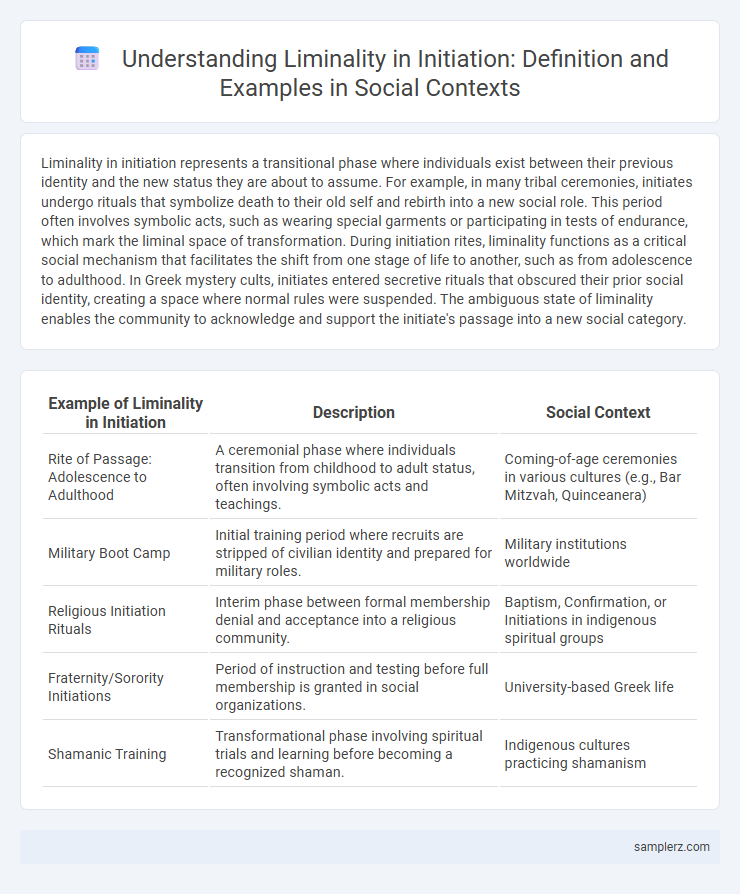Liminality in initiation represents a transitional phase where individuals exist between their previous identity and the new status they are about to assume. For example, in many tribal ceremonies, initiates undergo rituals that symbolize death to their old self and rebirth into a new social role. This period often involves symbolic acts, such as wearing special garments or participating in tests of endurance, which mark the liminal space of transformation. During initiation rites, liminality functions as a critical social mechanism that facilitates the shift from one stage of life to another, such as from adolescence to adulthood. In Greek mystery cults, initiates entered secretive rituals that obscured their prior social identity, creating a space where normal rules were suspended. The ambiguous state of liminality enables the community to acknowledge and support the initiate's passage into a new social category.
Table of Comparison
| Example of Liminality in Initiation | Description | Social Context |
|---|---|---|
| Rite of Passage: Adolescence to Adulthood | A ceremonial phase where individuals transition from childhood to adult status, often involving symbolic acts and teachings. | Coming-of-age ceremonies in various cultures (e.g., Bar Mitzvah, Quinceanera) |
| Military Boot Camp | Initial training period where recruits are stripped of civilian identity and prepared for military roles. | Military institutions worldwide |
| Religious Initiation Rituals | Interim phase between formal membership denial and acceptance into a religious community. | Baptism, Confirmation, or Initiations in indigenous spiritual groups |
| Fraternity/Sorority Initiations | Period of instruction and testing before full membership is granted in social organizations. | University-based Greek life |
| Shamanic Training | Transformational phase involving spiritual trials and learning before becoming a recognized shaman. | Indigenous cultures practicing shamanism |
Understanding Liminality in Social Initiation
Liminality in social initiation manifests during rites of passage where individuals transition from one social status to another, such as adolescence to adulthood in tribal ceremonies. This period is characterized by ambiguity, separation from previous roles, and a sense of communitas among initiates, dissolving prior social hierarchies. Understanding this transformative phase reveals its role in reinforcing social cohesion and individual identity within cultural frameworks.
Initiation Rites: Crossing the Threshold
Initiation rites often include a liminal phase where participants cross the threshold from their previous social status to a new identity, exemplified by rituals such as the Maasai warrior ceremony or the Apache puberty rites. During this transitional period, initiates experience symbolic death and rebirth, marked by separation from their community and immersion in structured challenges or teachings. This liminal state facilitates transformation and integration into the social group with new roles and responsibilities.
The Role of Rituals in Social Liminal Spaces
Rituals in social initiation ceremonies serve as crucial liminal spaces where participants transition from one social status to another, marked by symbolic acts and communal engagement. These rituals often involve rites of passage that temporarily suspend conventional social roles, creating a shared experience of ambiguity and transformation. The structured use of symbols, gestures, and collective participation in these rituals facilitates identity reconstruction and social cohesion during liminality.
Cultural Examples of Liminal Initiation Moments
Rites of passage such as the Maasai's Eunoto ceremony exemplify liminality by marking the transition from warrior to elder through symbolic acts and communal rituals. During these moments, initiates exist betwixt and between social statuses, embodying ambiguity and potential transformation. This cultural liminal phase fosters identity reformation and reinforces community cohesion through shared and codified experiences.
Psychological Impact of Liminal Initiation
Liminal initiation rituals often trigger profound psychological transformations by placing individuals in transitional states between social roles, fostering heightened self-awareness and identity reconfiguration. This in-between phase challenges existing cognitive frameworks and promotes adaptability, resilience, and emotional growth essential for integrating into new social statuses. Studies on rites of passage reveal that the psychological impact of liminal initiation significantly influences long-term personal development and social cohesion.
Traditional Ceremonies as Liminal Experiences
Traditional ceremonies serve as powerful liminal experiences by marking the transition between social statuses through symbolic rites of passage. Rituals such as initiation ceremonies in Indigenous cultures immerse individuals in a threshold phase characterized by ambiguity and transformation, effectively separating their previous identity from their new social role. These ceremonies facilitate communal recognition of change, reinforcing social cohesion and cultural continuity.
Community Transformation through Initiation
Initiation rites mark a liminal phase where individuals undergo symbolic death and rebirth, facilitating personal and communal transformation. During this threshold period, participants detach from previous social roles, allowing the community to redefine collective identity and social cohesion. This shared liminal experience strengthens bonds, fosters cultural continuity, and promotes social integration within the community.
Liminality and Identity Formation in Initiation
Liminality in initiation rituals marks a transformative phase where individuals exist betwixt and between social statuses, facilitating profound identity formation. During this transitional period, participants often undergo symbolic acts that dissolve previous self-conceptions, enabling the reconstruction of identity aligned with community values. Such rites of passage highlight the social function of liminality in reshaping personal and group identities through structured ambiguity and reflection.
Modern Social Initiations: New Liminal Spaces
Modern social initiations create new liminal spaces where individuals transition between social roles through rites of passage such as onboarding programs in corporate settings or virtual reality experiences in digital communities. These liminal spaces facilitate transformation by suspending previous identities and encouraging the adoption of new social norms, fostering a sense of belonging and identity reshaping. Examples include immersive orientation retreats for employees and online multiplayer games that simulate graduation ceremonies or clan inductions.
Navigating the Betwixt and Between of Initiation
Initiation rituals exemplify liminality by placing individuals in a transitional phase where social status is temporarily suspended, creating a space for personal transformation. Participants navigate this "betwixt and between" state, shedding old identities and embracing new roles within their community. This liminal period fosters ambiguity and openness, essential for redefining social belonging and cultural integration.

example of liminality in initiation Infographic
 samplerz.com
samplerz.com